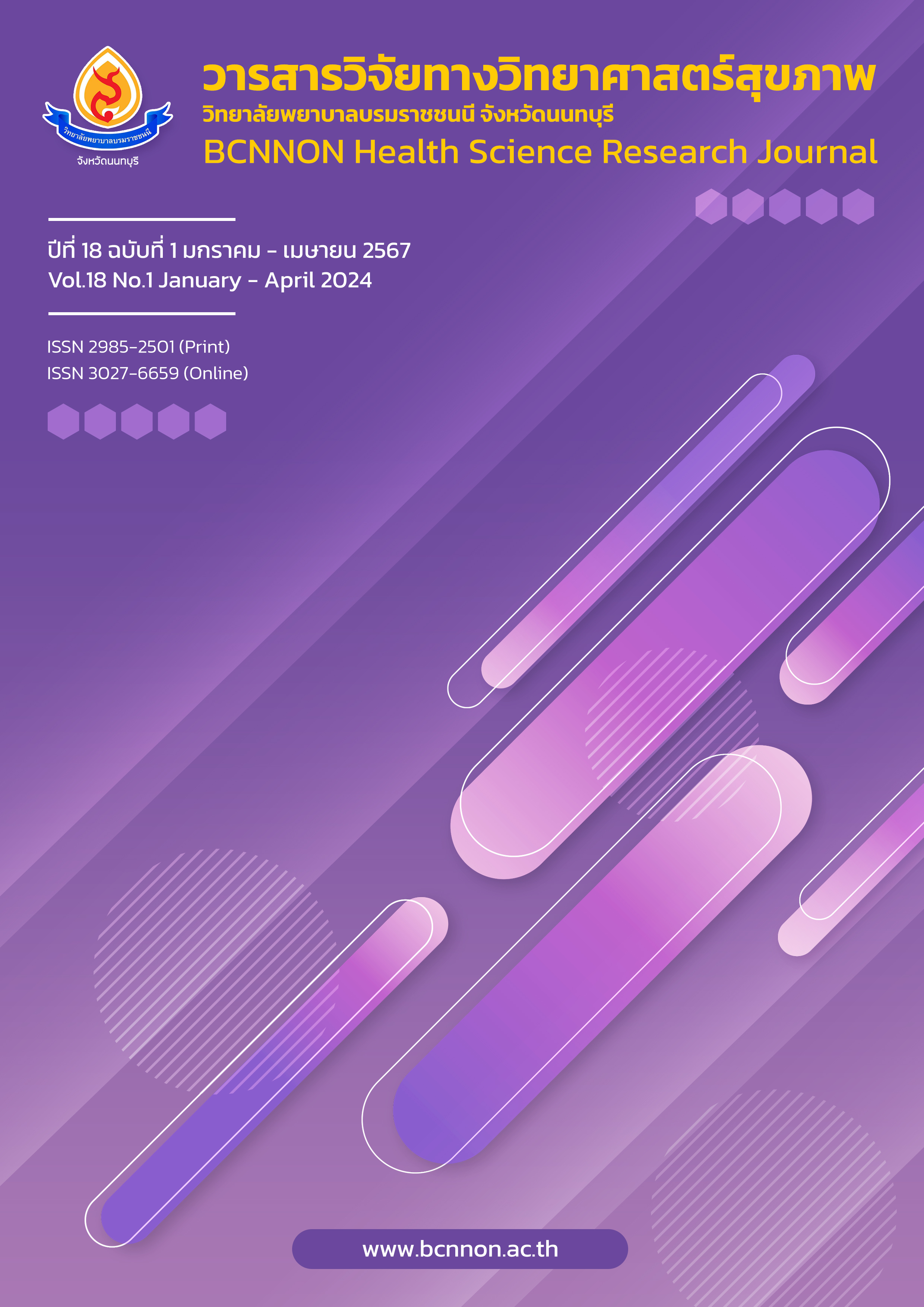ปัจจัยที่มีความสัมพันธ์กับการเกิดอาการคอมพิวเตอร์วิชั่นซินโดรมในพนักงานธนาคาร
Main Article Content
บทคัดย่อ
บทนำ : อาการคอมพิวเตอร์วิชั่นซินโดรมเป็นความผิดปกติทางตาและการมองเห็นจากการใช้คอมพิวเตอร์ในการทำงานเป็นระยะเวลานาน
วัตถุประสงค์การวิจัย : เพื่อศึกษาการเกิดอาการคอมพิวเตอร์วิชั่นซินโดรมและปัจจัยที่สัมพันธ์กับการเกิดอาการคอมพิวเตอร์วิชั่นซินโดรมในพนักงานธนาคาร
วิธีการวิจัย : การศึกษาเชิงพรรณนาหาความสัมพันธ์ ตัวอย่างคือ พนักงานธนาคาร จำนวน 396 ราย สุ่มตัวอย่างแบบง่าย เครื่องมือประกอบด้วย แบบสอบถามอาการคอมพิวเตอร์วิชั่นซินโดรม และแบบสอบถามปัจจัยที่สัมพันธ์กับการเกิดอาการคอมพิวเตอร์วิชั่นซินโดรม วิเคราะห์ข้อมูลโดยสถิติเชิงพรรณนา และการถดถอยโลจิสติกอย่างง่าย
ผลการวิจัย : ตัวอย่าง ร้อยละ 68.4 มีอาการคอมพิวเตอร์วิชั่นซินโดรม อาการที่พบบ่อยครั้งมากที่สุด คือ อาการแสบตา ร้อยละ 28.8 รองลงมา คือ อาการตาพร่ามัว ร้อยละ 26.0 โดยทุกอาการมีความรุนแรงปานกลาง ปัจจัยที่มีความสัมพันธ์กับการเกิดอาการคอมพิวเตอร์วิชั่นซินโดรม ประกอบด้วยปัจจัยด้านสภาพการทำงาน ได้แก่ ระยะเวลาทำงานหน้าจอคอมพิวเตอร์ 3-4 ชั่วโมงต่อวัน (OR=4.75; 95% CI=1.24, 18.19) 5-6 ชั่วโมงต่อวัน (OR=6.93; 95% CI= 2.06, 23.30) และมากกว่า 8 ชั่วโมงต่อวัน (OR=10.94; 95% CI=3.13, 38.28) การมองจอสลับกับเอกสาร (OR=2.97; 95% CI=1.61, 5.49) และปัจจัยด้านสิ่งแวดล้อมในการทำงาน ได้แก่ แสงสว่างหน้าจอที่จ้าเกินไป (OR=7.90; 95% CI=1.04, 60.29) และแสงสะท้อนจากหน้าต่าง (OR=1.72; 95% CI=1.02, 2.99) อย่างมีนัยสำคัญทางสถิติ (p<.05)
สรุปผล : พยาบาลอาชีวอนามัยควรออกแบบโปรแกรมเพื่อป้องกันการเกิดอาการคอมพิวเตอร์วิชั่นซินโดรมในพนักงานธนาคาร โดยเน้นการปรับระยะเวลาการใช้คอมพิวเตอร์ให้เหมาะสม และปรับแสงสว่างหน้าจอให้เหมาะสม
Downloads
Article Details

อนุญาตภายใต้เงื่อนไข Creative Commons Attribution-NonCommercial-NoDerivatives 4.0 International License.
บทความที่ได้รับการตีพิมพ์เป็นลิขสิทธิ์ของวิทยาลัยพยาบาลบรมราชชนนี จังหวัดนนทบุรี
ข้อความที่ปรากฏในบทความแต่ละเรื่องในวารสารวิชาการเล่มนี้เป็นความคิดเห็นส่วนตัวของผู้เขียนแต่ละท่านไม่เกี่ยวข้องกับวิทยาลัยพยาบาลบรมราชชนนี จังหวัดนนทบุรี และคณาจารย์ท่านอื่น ในวิทยาลัยฯ แต่อย่างใด ความรับผิดชอบองค์ประกอบทั้งหมดของบทความแต่ละเรื่องเป็นของผู้เขียนแต่ละท่าน หากมีความผิดพลาดใด ๆ ผู้เขียนแต่ละท่านจะรับผิดชอบบทความของตนเองแต่ผู้เดียว
เอกสารอ้างอิง
American Optometric Association. Computer vision syndrome. [internet]. 2022 [cites 2022 Jan 8]; Available from: https://www.aoa.org/patients-and-public/caring-for-your-vision/protecting-your-vision/computer-vision-syndrome. (in Thai).
Randolph SA. Computer vision syndrome. Workplace Health Saf. 2017;65(7):328. doi: 10.1177/2165079917712727.
Adane F, Alamneh YM, Desta M. Computer vision syndrome and predictors among computer users in Ethiopia: a systematic review and meta-analysis. Trop Med Health. 2022;50(1):26. doi: 10.1186/s41182-022-00418-3.
National Statistical Office Thailand. Household information and communication technology survey 2020. [internet]. 2021 [cited 2022 Jul 9]; Available from: https://www.nso.go.th/nsoweb/nso/survey_detail/jJ. (in Thai).
Alabdulkader B. Effect of digital device use during COVID-19 on digital eye strain. Clin Exp Optom. 2021;104(6):698-704. doi: 10.1080/08164622.2021.1878843.
Photihung P. Factors related to computer vision syndrome in working group, Thailand: a systematic review of literature. The Journal of Faculty of Nursing Burapha University. 2016;24(4):1-14. (in Thai).
Photihung P, Srisopa P, Tassanatanachai A. Risk factors of computer vision syndrome among instructors, Burapha University. Journal of Nursing and Education. 2016;9(2):104-19. (in Thai).
Tubtimhin S, Puthaburi N. Prevalence and severity of computer vision syndrome of supporting staff in Ubon Ratchathani University. Srinagarind Medical Journal. 2019;34(2):173-7. (in Thai).
Rungsirisangratana C, Pinsuwannabud P, Hirunphasert C. Computer vision syndrome among office workers in three factories in Phrapradaeng District, Samutprakarn province. Journal of Preventive Medicine Association of Thailand. 2020;10(1):21-35. (in Thai).
Chidnayee S, Chidnayee J, Kuariyakul A. Risk factors for computer visual syndrome and prevalence of vision problems in nursing students of Borommrajonani College of Nursing, Uttaradit. Nursing Public Health and Education Journal. 2015;16(2):13-22. (in Thai).
Photcharapngsakul C. Associated factors of digital eye strain among clinical years’ medical students and treatment results using single-dose unit artificial tears. Lampang Medical Journal. 2021;42(2): 63-73. (in Thai).
Lurati AR. Computer vision syndrome: implications for the occupational health nurse. Workplace Health Saf. 2018;66(2): 56-60. doi: 10.1177/2165079917731790.
Ranasinghe P, Wathurapatha WS, Perera YS, Lamabadusuriya DA, Kulatunga S, Jayawardana N, et al. Computer vision syndrome among computer office workers in a developing country: an evaluation of prevalence and risk factors. BMC Res Notes. 2016;9:150. doi: 10.1186/s13104-016-1962-1.
Uchino M, Uchino Y, Dogru M, Kawashima M, Yokoi N, Komuro A, et al. Dry eye disease and work productivity loss in visual display users: the Osaka study. Am J Ophthalmol. 2014;157(2):294-300. doi: 10.1016/j.ajo.2013.10.014.
Shah M, Saboor A. Computer vision syndrome: prevalence and associated risk factors among computer-using bank workers in Pakistan. Turk J Ophthalmol. 2022;52(5):295-301. doi: 10.4274/tjo. galenos.2021.08838.
Kamoy B, Magno M, Noland ST, Moe MC, Petrovski G, Vehof J, et al. Video display terminal use and dry eye: preventive measures and future perspectives. Acta Ophthalmol. 2022;100(7):723-39. doi: 10.1111/aos.15105.
Assefa NL, Weldemichael DW, Alemu HW, Anbesse DH. Prevalence and associated factors of computer vision syndrome among bank workers in Gondar City, northwest Ethiopia, 2015. Clin Optom (Auckl). 2017;9:67-76. doi: 10.2147/OPTO.S126366.
Bank for Agriculture and Agricultural Cooperatives. Contact BAAC. [internet]. 2019 [cited 2022 Jul 19]; Available from: https://www.baac.or.th/th/content-contact.ph p?content_group_sub=7. (in Thai).
Yamane T. Statistic: an introductory analysis. 3rd ed. New York: Harper and Row; 1973.
Segui MdR, Cabrero-Garcia J, Crespo A, Verdu J, Ronda E. A reliable and valid questionnaire was developed to measure
computer vision syndrome at the workplace. J Clin Epidemiol. 2015;68(6):662-73. doi: 10.1016/j.jclinepi.2015.01.015.
Derbew H, Nega A, Tefera W, Zafu T, Tsehaye K, Haile K, et al. Assessment of computer vision syndrome and personal risk factors among employees of commercial bank of Ethiopia in Addis Ababa, Ethiopia. J Environ Public Health. 2021;2021: 6636907. doi: 10.1155/2021/6636907.


